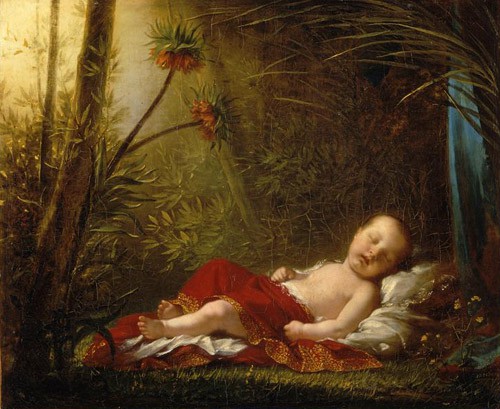Picking up his quill after viewing the Portrait de S.M. le Roi de Rome, one of three paintings exhibited at the Salon of 1812 by Prud’hon, the well-known writer Charles Paul Landon* was moved to offer his own textual reproduction of the work: “The august child is depicted without clothes, asleep in the grass. His head rests on a cushion, his body lies across a crimson, gold-stitched cloth. The verdant shoots of laurel, myrtle and the herb known as the imperial flower bow down before him, as if to salute him and promise him the strength of the great North Wind. The light, like that of the dawning of the day, illuminates this gracious composition, distinguished by its smooth brushwork and fresh palate. The figure of H.M. the Roi de Rome is close to life size.”
Unlike the heavy-handed royal imagery of Callet’s work (Allégorie sur la naissance de Sa Majesté le Roi de Rome, n° 153, complete with cradle in the sky and an eagle in the foreground, holding in its beak the Iron Crown of Lombardy), which was exhibited at the same salon, the strength of Prud’hon’s painting lies in the power of suggestion. In this work from the man known as “the French Correggio”, radiant, early morning light gently caresses the babe, put to bed in surroundings of natural serenity. Above his head is an archway of imperial crown fritillaries, a reference to his maternal bloodline, and palm leaves, which allude to the successes of his father, with, in the background, an abundance of laurel. Blue drapes, a white cushion and the crimson cover form the tricolour; although arranged naturally, these objects constitute the only artificial elements in this scene of gentle and benevolent nature. Who is this newborn? Baby Jesus, asleep under the watchful eye of a paternal divine providence? Or Romulus, son of Mars and Rea Silvia and future founder of Rome, abandoned but soon to be taken in by a suckling she-wolf? Does he herald a new Eden, or rather the arrival of a new golden age?
This pantheistic symphony could not fail to turn the minds of its contemporaries – instilled with a love of classical culture – to Virgil’s fourth Eclogue:
“For thee, O boy/First shall the earth, untilled, pour freely forth/Her childish gifts, the gadding ivy-spray/With foxglove and Egyptian bean-flower mixed, /And laughing-eyed acanthus./[…]Thy very cradle shall pour forth for thee/Caressing flowers.”
On 29 March, 1814, just seventeen months after the opening of the 1812 Salon at the Musée Napoléon (now the Louvre), the child – so indulgently depicted by the brushes of painters and chisels of sculptors – was torn from the Tuileries Palace and thrown into the streets, condemned to wander. His travels took him from Blois to Austria, where he remained in exile; any hopes for a new golden age had been dashed by the wrought iron of the European coalition.
* Charles-Paul Landon, Annales du musée et de l’École moderne des beaux-arts, Salon 1812, Paris, Annales du Musée, 1812, tome I, p. 94-95
Christophe Beyeler (tr. H.D.W.)
Conservateur du patrimoine chargé du musée Napoléon Ier – château de Fontainebleau
Curator, “Enfance impériale. Le Roi de Rome, fils de Napoléon”
March 2011


